Knowing how to tune an instrument is an essential skill for a musician of any caliber. Whether you’re a complete beginner or a seasoned pro, knowing how to tune your guitar, bass or ukelele is usually the first step before starting your musical endeavors.
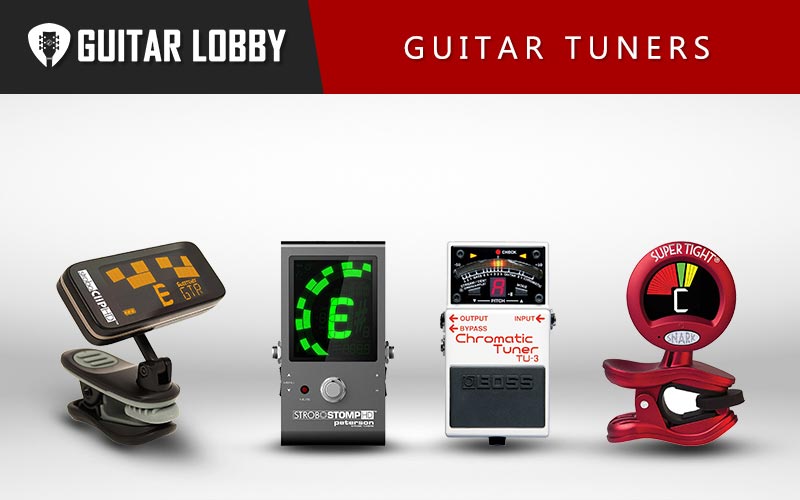
In fact, a lot of innovation in the tuning industry has happened in the last 70 odd years, and tuning is now reliable and accessible for any musician at any skill level. At the same time, there are a lot of products in the market that can often mislead or deliver less than substantial results.
There can be a lot of questions when it comes to what tuner to buy for either acoustic or electric guitar. I’ll start this article by reviewing the best guitar tuners at each price point, but if you want to learn more about them and the different types, check out our guitar tuner information guide at the bottom of the page here.
| Name of Product | Image of Product | Description | Price Range | Full Review |
|---|---|---|---|---|
| 1. TC electronic Polytune 3 (Editor’s Choice) | 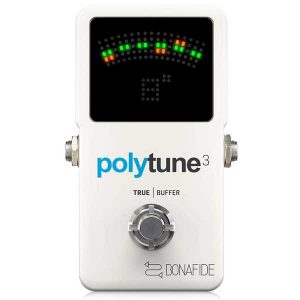 | Tuner Type: Pedal Tuner Display Type: Chromatic and Polyphonic | $100 | Read Full Review Below |
| 2. BOSS TU-3 Chromatic (Best Pedal Overall) | 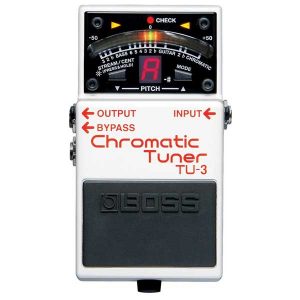 | Tuner Type: Pedal Tuner Display Type: Chromatic and Strobe | $100 | Read Full Review Below |
| 3. Snark ST-2 Super Tight (Best Value) | 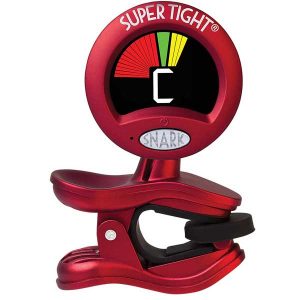 | Tuner Type: Clip On Tuner Display Type: Chromatic | $15 | Read Full Review Below |
| 4. TC Electronic Polytune Clip (Best Clip On Tuner) | 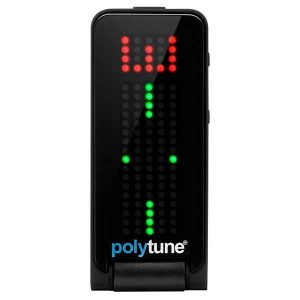 | Tuner Type: Clip On Tuner Display Type: Chromatic, Polyphonic and Strobe | $50 | Read Full Review Below |
| 5. Peterson Stroborack (Best Rackmount) | 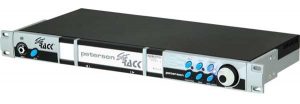 | Tuner Type: Rack-Mounted Tuner Display Type: LCD | $450 | Read Full Review Below |
| 6. Korg PitchBlack Advance | 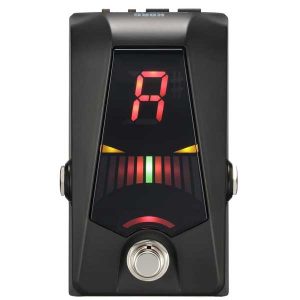 | Tuner Type: Pedal Tuner Display Type: Strobe, Half-Strobe, Meter and Mirror | $65 | Read Full Review Below |
| 7. Peterson Strobostomp HD | 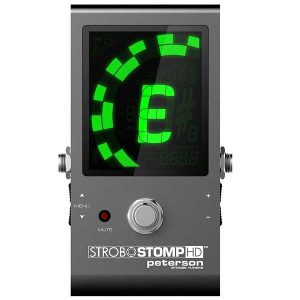 | Tuner Type: Pedal Tuner Display Type: Strobe | $132 | Read Full Review Below |
| 8. D’addario CT-20 | 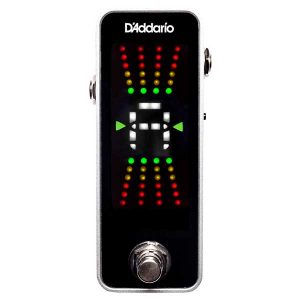 | Tuner Type: Pedal Display Type: Chromatic LED | $90 | Read Full Review Below |
| 9. D’addario NS Micro | 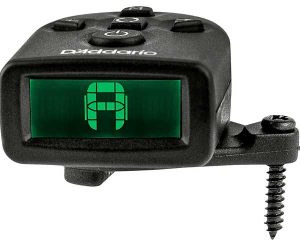 | Tuner Type: Clip On Tuner Display Type: Chromatic | $15 | Read Full Review Below |
| 10. Korg Sledgehammer Pro | 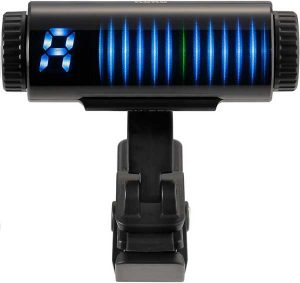 | Tuner Type: Clip On Tuner Display Type: Regular, Strobe and Half Strobe | $20 | Read Full Review Below |
| 11. Peterson StroboClip HD | 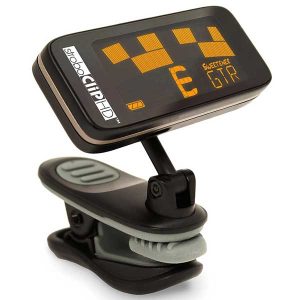 | Tuner Type: Clip On Tuner Display Type: Strobe | $70 | Read Full Review Below |
| 12. Roadie 2 Motorised Tuner | 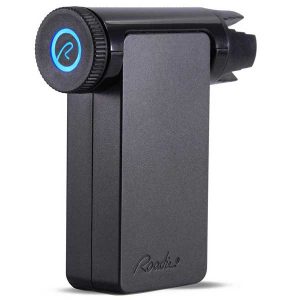 | Tuner Type: Motorized Tuner Display Type: OLED display | $130 | Read Full Review Below |
| 13. GuitarTuna Guitar Tuning App |  | Phone App | Free and Paid Versions | Read Full Review Below |
| 14. Fender Tune Guitar Tuning App |  | Phone App | Free and Paid Versions | Read Full Review Below |
Here Are the Best Guitar Tuners
1. TC Electronic Polytune 3 (Editor’s Choice)
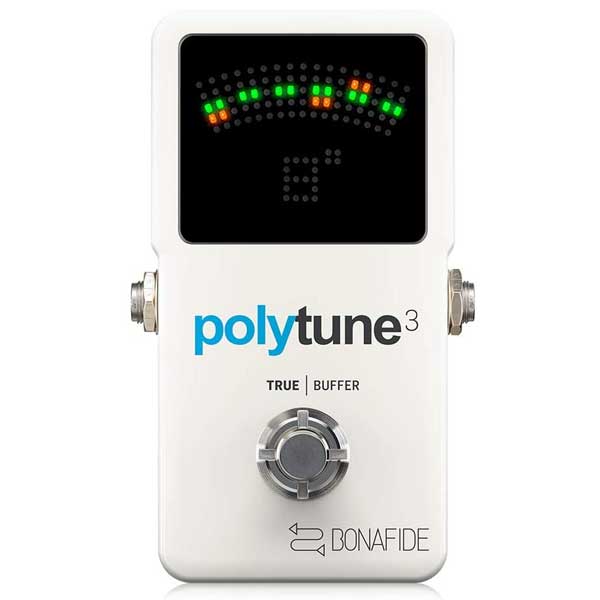
| Estimated Price | $100 for The Polytune 3 and $90 for Polytune 3 Mini |
| Tuner Type | Pedal Tuner |
| Display Type | Chromatic and Polyphonic |
| Accuracy | +/- 0.2 percent |
| Alternate Tunings Available | Capo and DADGAD |
My Review: The Danish Electronics company, TC Electronic has a long history of making specialist guitar pedals and accessories. Some of their famous guitar pedals like the Ditto Looper or the recently released Dark Matter distortion pedals are really popular with guitar players at all levels. Their Polytune series of tuners have also received rave reviews ever since the first version. Let’s take a look at some of the features of this polyphonic tuner pedal.
Build Quality: Both the Polytune 3 and the Polytune 3 mini have essentially the same feature set but come in either full size or mini-pedal formats. The outer casing is made from durable aluminum and features a soft pushbutton. Both the Polytune 3 and mini also come in a dark “noir” edition featuring black aesthetics. The pedals feature a switchable bypass mode. Either a true bypass that completely disengages the pedal from the signal chain or a buffered bypass that performs some amplification to compensate for longer cables and protects signal strength.
Speed and Accuracy: The Polytune automatically engages chromatic mode or polyphonic mode tuning depending on the incoming signal. The chromatic mode has an accuracy of 0.2 percent and with a bright screen and easy to read red and green LEDs, performing a thorough tuning is quite easy. The polyphonic mode is more for quick tune-ups between songs on stage or in the studio and prioritizes speed over accuracy with a 0.5 percent threshold. This pedal also includes a strobe tuner mode with a hyper-precise ± 0.02 threshold which is great for applications like quad tracking rhythm guitars.
Alternate Modes and Tunings: The Polytune series supports multiple alternate modes and tunings with support for open string tunings like DADGAD or capo based tunings as well.
Who Is It For: The performance of the Polytune series pedals is considered best-in-class and at this price range, the feature set of the Polytune is hard to match. The mini version comes in handy for players who need a compact form factor over a larger and clearer display. The Polytune uses a 9V power supply or runs on 9V batteries with battery life averaging around 12-15 hours with buffered bypass engaged. All these reasons are enough for TC electronics’ Polytune to be considered among the best tuner pedals available today. Considering its price and performance this is easily one of the best guitar tuners out there.
Notable Features:
- Available in full size or mini pedal formats.
- Proprietary Bonafide Buffer technology offers signal amplification for larger cables or elaborate setups.
- The full-size pedal provides power as well through 9V passthrough jack.
- 3 Tuning modes – Chromatic, Strobe, and Polyphonic with high degrees of accuracy.
- Bright LED display for on-stage use while providing decent battery life (12-15 hours)
- Available in light and dark “noir” variants
2. BOSS TU-3 Chromatic Tuner (Best Pedal Overall)
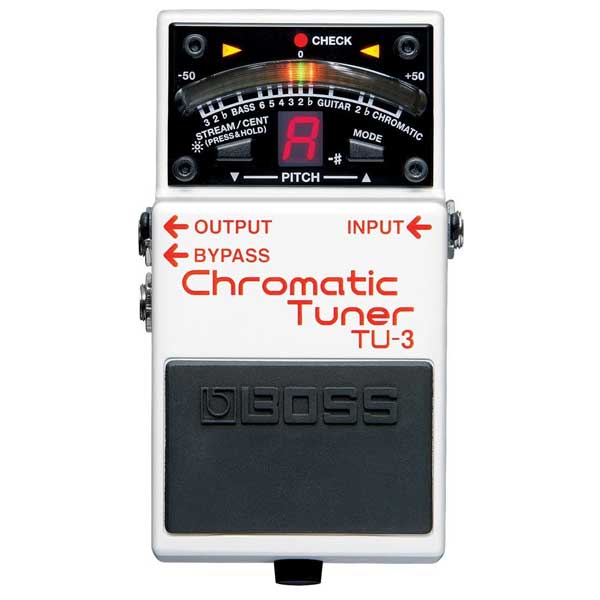
| Estimated Price | $100 |
| Tuner Type | Pedal Tuner |
| Display Type | Chromatic and Strobe |
| Accuracy | +/- 0.1 percent |
| Alternate Tunings Available | Yes, for both guitar and bass |
My Review: BOSS corporation, is a subsidiary of the famous Roland Corporation and has been in the business of making compact effects pedals for guitar players since the 70s. They’re known for being affordable, yet highly durable and their no-nonsense operation makes them an ideal choice for newer guitar players. For the Notable Features, BOSS releases special editions of their pedals via their “Waza” custom shop that adds higher quality components or additional features. Let’s take a look at their TU line of tuner pedals, specifically the TU-3 and its variants, the compact TU-3s, and the Waza custom edition TU-3s.
Build Quality: It’s no surprise that the BOSS TU-3 is built like a tank. Like its other compact pedals, the BOSS TU-3 is built for the road. The TU-3 is the standard version, with true bypass and 2 operating modes. The TU-3s is the compact version that removes the pedal switch for an always-on approach. The TU-3w meanwhile is customized by the famous Waza Soundcraft, and adds a specially tuned buffered bypass mode, and comes in a sleek black finish. The meters and LEDs are common to all these pedals.
Speed and Accuracy: The TU-3 lends a lot of credence to BOSS’s idea of ‘less is more’. The LED meter at the top can be switched between a guitar/bass tuning oriented “Cent Mode” or a more traditional strobe-like “Stream Mode”. Both these modes are easy to access and quick to tune. The TU-3 is accurate to 1 percent, mostly due to the analog tuning readout, but the results are quick and consistent. The display retains readability with a special outdoor mode, for use in bright environments.
Alternate Modes and Tunings: The BOSS TU-3 pedal comes with a lot of options for alternate tunings for guitar/bass. The specialized guitar/bass tuning mode allows for tuning based on string numbers and supports up to 7 stringed guitars and 6 string basses. The pedal also has a flat tuning mode, that can tune guitars with drop tunings all the way down to -6 semitones. The stream mode allows for higher accuracy but is a slower way for tuning guitars and bass.
Who Is It For: The BOSS TU-3 is one of the oldest and most reliable tuner pedals on the market. Many guitar players love it for its dependability and ease of use. Its ability to power a high number of other boss pedals (up to 7) is a big plus for the TU-3. The standard edition is priced competitively. The Waza edition is priced a little higher but it can be considered, for the advanced bypass mode and sleek looks. If you’re already using BOSS pedals in your setup, this can be a great answer to your tuning needs. In my opinion, this is the best guitar tuner pedal out there right now that’s reasonably priced.
Notable Features:
- 3 different editions
- Compact – compact and always on
- Standard – tried and tested BOSS functionality
- Waza – sleek looks and a specialized buffered bypass
- Auto Mute Function
- High Brightness LED readout for outdoor use
- True Bypass Mode
- Powers up to 7 BOSS compact pedals
- Strobe style and Chromatic
3. Snark ST-2 Super Tight (Best Value)
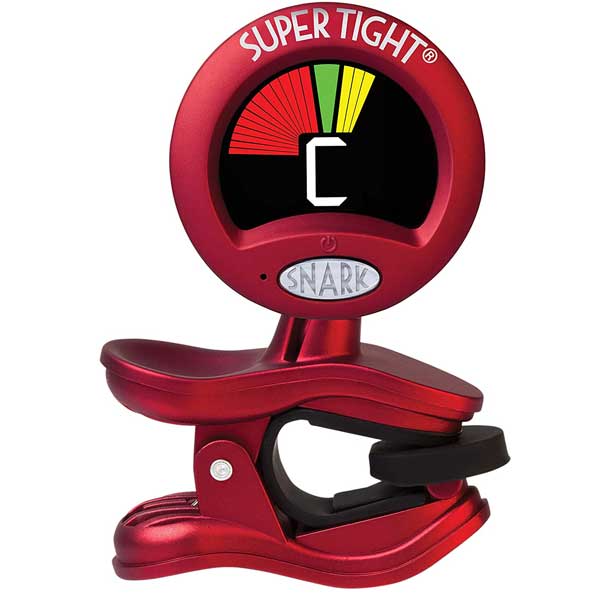
| Estimated Price | $15 |
| Tuner Type | Clip On Tuner |
| Display Type | Chromatic |
| Accuracy | Not Specified By Brand (Uses Internal Mic + Vibration Sensor) |
| Alternate Tunings Available | No |
My Review: The ST-2 Super Tight is a versatile, all-instrument tuner that can tune in two different ways, giving you the freedom to use the mic or the tuner’s vibration sensor. With a high definition display screen, ‘super tight’ clasp and a 360-degree swivel head allows you to easily clip it onto your instrument and tune-up accurately and swiftly within minutes. With an adjustable calibration range between 415 to 466Hz, you can tune it in a variety of standard pitches. The pocket-friendly price makes it an even sweeter of a deal.
Build Quality: The tuner comes in a pretty snazzy red color with a circular display. The clip-on clasp is quite sturdy and really holds on to your instrument. The bright display screen allows you to effortlessly see the visuals even under low light situations. The swivel head is turnable to a full 360 degrees, making it workable for both right and left-handed guitarists.
The tuner works on a CR 2032 battery which can last a decent while. However, to make sure that you turn off the tuner once you’re done using it. It doesn’t have an auto-off feature, which means you could drain its entire power if you’re not careful.
Speed and Accuracy: The ST-2 claims to work on all kinds of instruments, whether they are stringed, wind, or others. This is thanks to the internal mic installed within the tuner, and the high-sensitivity vibration sensor. Both modes offer impressive accuracy, so you can choose whichever mode to tune in, depending on the instrument. It has an adjustable calibration range between 415 to 466Hz, allowing you to tune in a variety of pitches.
Alternate Modes and Tunings: The tuner also comes with a tap tempo metronome functionality. All you have to do is tap the desired rhythm pattern onto the tuner, and it continues to beep in the same BPM (beats per minute). This makes it quite handy to quickly figure the tempo of a song you’re planning to jam on, be it in the am room or onstage.
Who Is It For: Given its reasonable price, accuracy, and versatile tuning options, this turn makes for a good value of money. With a single tuner, you can tune not only your acoustic guitar but your electric, bass, woodwinds, and a variety of other instruments as well.
Notable Features:
- Multi-purpose, versatile clip-on tuner
- Tunes based on both internal mic and vibration sensor
- All-instrument tuner
- 360-degree swivel head for both right and left-handed guitarists
- Adjustable calibration between 415 to 466 Hz
- Tap metronome functionality
Related Article: The Best and Most Accurate Guitar Tuners (All Price Ranges)
4. TC Electronic Polytune Clip (Best Clip On Tuner Overall)
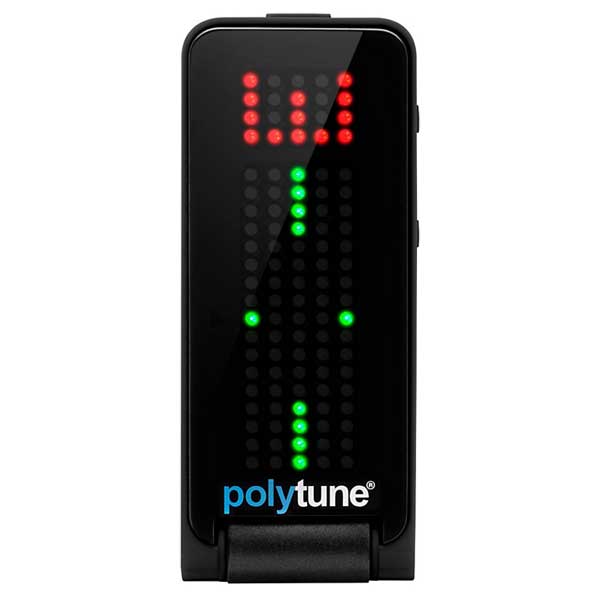
| Estimated Price | $50 |
| Tuner Type | Clip On Tuner |
| Display Type | Chromatic, Polyphonic, and Strobe |
| Accuracy | +/- 0.02 percent |
| Alternate Tunings Available | Chromatic Only Mode |
My Review: The TC Electronic Polytune clip-on tuner offers you the freedom to go for high-precision polyphonic or chromatic tuning with this versatile and easy to use model. A compact and sleek device, it has a large and bright display that has both regular and ultra-accurate strobe display modes. The adaptive display mode adjusts the orientation of the display according to your movement. With its flat tuning and capo tuning features, this is a versatile, durable, and nifty tuner to have in your music toolbox.
Build Quality: With a compact and clean design, the Polytune boasts of a stylish yet functional look. The stainless steel clip is sturdy and durable, clasping neatly onto the instrument. It’s a wonder how TC managed to cramp its polyphonic tuning software into this tiny device, but we love it. The adaptive display senses your direction and orientation and adjusts the visuals accordingly. Moreover, you have the choice to view it in the regular chromatic or the strobe mode, for extra precision tuning. Its battery life is also a force to reckon with, with a running time of up to 18 hours on a single CR2032 lithium coin battery.
Speed and Accuracy: The Polytune gives you the choice to go for high precision polyphonic tuning, which means being able to tune all 6 of your strings in one go. Alternately, you can tune it in the regular chromatic way as well. The strobe tuner functionality tunes with a pretty neat accuracy of +/- 0.02 percent.
Alternate Modes and Tunings: Aside from the chromatic and the polyphonic tuning modes, Polytune has a couple of other interesting features in store. It also has a flat tuning mode as well as a capo mode, which can be very useful when you’re playing alternate tunings.
Who Is It For: Given its ability to accurately tune both in polyphonic and chromatic modes, the polytune is quite a reliable and versatile tuner to have with you. Whether you’re a left or right-handed guitarist or play the bass, acoustic or electric guitar, the Polytune’s ability to accurately tune in all situations makes it quite a sweet deal. While the clip on tuner reviewed above is a better value, the extra cost of this pedal is justified and in my opinion, it’s the best clip on guitar tuner out there.
Notable Features:
- Accurate and compact polyphonic tuner
- Offers both polyphonic and chromatic tuning
- Bright display for an accurate reading
- Strobe tuning display with +/- 0.02 percent precision
- Running time of up to 18 hours and power-saving auto-off feature
- Adaptive display for easy reading regardless of orientation
- Ideal for acoustic, electric guitar, and bass guitar
- Flat tuning and capo mode as well
5. Peterson Stroborack (Best Rackmount)
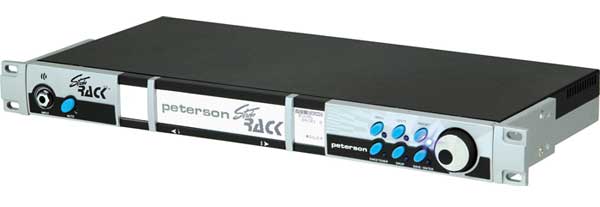
| Estimated Price | $419-499 depending on dealer |
| Tuner Type | Rack-Mounted Tuner |
| Display Type | LCD |
| Accuracy | +/- 0.1 percent |
| Alternate Tunings Available | 35 ‘Sweetened Tunings’ |
My Review: A lot of touring and professional guitar players require a steady rack setup that is stable and offers everything in one box, be it FX, amp modelers, or any other rack unit. The convenience of safely traveling with all this gear intact in a road-ready setup outweighs the compactness of pedals and if you have a dedicated rack setup and need a unit for your tuning needs, then no need to look further than the Peterson Stroborack. This rack-mounted unit offers cutting edge tuning performance in the studio or on the road.
Build Quality: The Stroborack is made from high-quality metal components and occupies 1unit space on most racks. It is sleek and has one input jack on the front facia, and another B input at the back. More inputs can be added via a dedicated I/O expander card. The large LCD screen on the front is bright and great for outdoor use and under stage lights. The right part of this display shows the reference pitch and the center acts as a responsive strobe tuner and can even show custom text when not in use.
Speed and Accuracy: The Stroborack from Peterson is unmatched in its tuning accuracy and only comparable to some other Peterson products. It offers 0.1 percent accuracy and even provides 35 custom ‘Sweetened Tunings’ that adapt the tuning temperament for different instruments or historic temperaments for orchestral instruments. It even offers 8 slots to store user-defined tunings as well. The display is quick and accurate and folks acquainted with strobe tuners will find themselves at ease with the Stroborack.
Who Is It For: The Stroborack isn’t for everyone, at a price nearly 4 times of any competing tuner pedal. However, for specific scenarios, such as road-ready tuning rig or in a studio, the Stroboracks’ accuracy and finesse are hard to match. The Sweetened tunings only heighten the utility of this rack-mounted strobe tuner.
For instrument players looking for dedicated tuning solutions to add to their rigs, the Stroborack performs better than any tuning pedal out there.
Notable Features:
- Rack-mounted high accuracy tuning unit uses only 1 unit rack space
- Giant LED display meant for use in bright conditions
- 35 Sweetened tuning presets and 8 customizable slots
- Multiple I/O options with a dedicated expander card
- Additional Rack convenience features like a lamp power socket
- Stroborack Remote Footswitch for hands-free muting
Related Popular Article: Recommended Guitar Amps (All Price Ranges)
6. Korg PitchBlack Advance
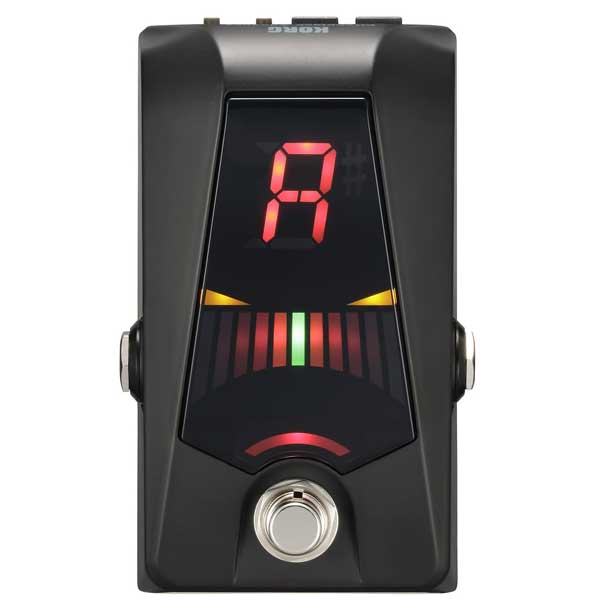
| Estimated Price | $65 |
| Tuner Type | Pedal Tuner |
| Display Type | Strobe, Half-Strobe, Meter, and Mirror |
| Accuracy | +/- 0.1 percent |
| Alternate Tunings Available | No |
My Review: The KORG corporation has been in the business of guitar processing and FX for quite some time, some of their famous brands include the VOX line of amplifiers, processors, and even guitars. KORG handheld strobe tuners are considered industry-standard in the world of orchestral instruments and tuned percussion for their super high accuracy. This reflects in their Pitchblack series of tuner pedals, the most recent of which is the Pitchblack Advance.
Build Quality: The Pitchblack Advance is a very handsome pedal. It comes in a sleek black finish with the curves at the top merging seamlessly with the giant LED display and a slightly tapered finish towards the bottom which angles the display towards the user. The display is quite bright for stage use and the red-green-yellow color scheme makes it super intuitive. The back of the pedal features 9V DC in and out connectors for powering other pedals as well.
Speed and Accuracy: This pedal can be operated in 4 modes – Strobe, Half-Strobe, Meter, and Mirror, all of which slightly vary the metering according to preference. The Pitch Black Advance is highly accurate – within a tenth of a percent making it one of the most accurate tuner pedals out there. I personally preferred the standard strobe and the mirror modes which made the display easier to read and lead to faster results. The Pitchblack Advance has a true bypass mode without any buffer ensuring a clear signal path.
Alternate Modes and Tunings: The reference pitch can be calibrated from the standard 436hz all the way to 445hz making it quite versatile for alternate temperaments. The pedal has a full tuning range from E0 to C8 making it suitable for other stringed instruments like a Bass guitar. However, the KORG pedal doesn’t support alternate tunings as it is fundamentally a chromatic/strobe tuner.
Who Is It For: The Pitchblack Advance from KORG is a solid performer. The brilliant and bright LED display takes the cake with accurate metering and easy to use operation. The sleek look and black aesthetics will make it fit within any discreet pedalboard setup. At this price range, the KORG lacks some definitive features like buffered bypass but this leads to an amazing battery life of close to 60 hours! The noise-reduction circuitry helps to clean up the cable noise without affecting the signal.
Notable Features:
- 60+ hour battery life thanks to true-bypass
- Sleek Black Design and durable aluminum construction
- High degree of tuning accuracy – range within 0.1 percent
- Bright LED display with 4 modes including strobe and half-strobe operation.
- DC out for powering other pedals
- Built-in noise reduction circuitry
7. Peterson Strobostomp HD
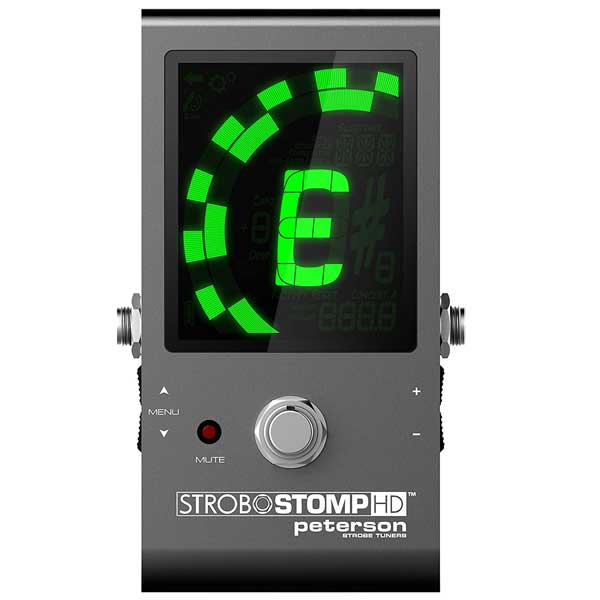
| Estimated Price | $132 |
| Tuner Type | Pedal Tuner |
| Display Type | Strobe |
| Accuracy | +/- 0.1 percent |
| Alternate Tunings Available | 50+ pre-sweetened custom tunings |
My Review: The Peterson Strobostomp HD comes from the famous Peterson line of strobe tuners. Peterson pioneered the electronic handheld strobe tuner for musicians back in 1964 and since then has been at the cutting edge of tuning technology thanks to its focus on high accuracy and innovation. The Strobostomp HD is the newest in a line of highly accurate tuning pedals designed for professionals or for studio use. It is a significantly high-end pedal with a feature set and price deserving of the best.
Build Quality: The Strobostomp HD comes with a premium grey metal finish. The face of the device has a gigantic ‘HD’ LED display that displays the reference pitch and the strobes with accuracy. The front of the device has a micro USB port and DC in and out jacks. Small buttons on either side are used to navigate the UI. The USB port can be used to download custom profiles for the Strobostomp via the Peterson Connect system. The Strobostomp HD features only one input and output.
Speed and Accuracy: The Strobostomp HD is extremely accurate to ±0.1 percent. And the HD display helps to convey that information precisely. The reference pitch is visible in the center surrounded by the strobe effect which helps in efficiently matching the pitch. Although this pedal doesn’t come with an internal mic, it is more than capable of picking up and tuning other instruments like a harp. Exceptional pitch accuracy is the name of the game here.
Alternate Modes and Tunings: The Peterson Strobostomp HD does not have a strobe mode as such, that’s because it is fundamentally a strobe tuner. Peterson has made configurable custom tunings called “Sweetened tunings” to help people unfamiliar with strobe tuners to dial-in the tuning for their favorite guitars, bass, and a wide variety of other instruments. You can also change the temperament from equal to historic ones for replicating the feel of old orchestral compositions. It also compensates for slight intonation issues that might come with perfect equal temperament tuning on instruments like the Les Paul. Perfect for getting a crystal clear tone and sound, in studio situations.
Who Is It For: The Strobostomp HD is not cheap by any means, in fact, it pretty much leads the list in terms of price, but it offers top tier performance and functionality. The custom sweetened tunings are a feature that needs to be applied and heard to be believed. The high quality switchable buffered bypass and the noiseless true bypass are features that will matter to a few but can enhance the sound of any guitar. And just so we’re clear, a cheap well-tuned guitar sounds way better than an expensive one that’s not.
Notable Features:
- Professional Grade Strobe Tuner in Pedal form
- Custom ‘Sweetened’ Tunings dialed-in by Notable Features
- Bright and high-definition LED display
- High-grade buffered bypass
- Noiseless switchable bypass
- DC in and out jacks
- Micro USB port to update firmware and profiles
Related Article: The Best Bass Amps on the Market Right Now
8. D’addario CT-20
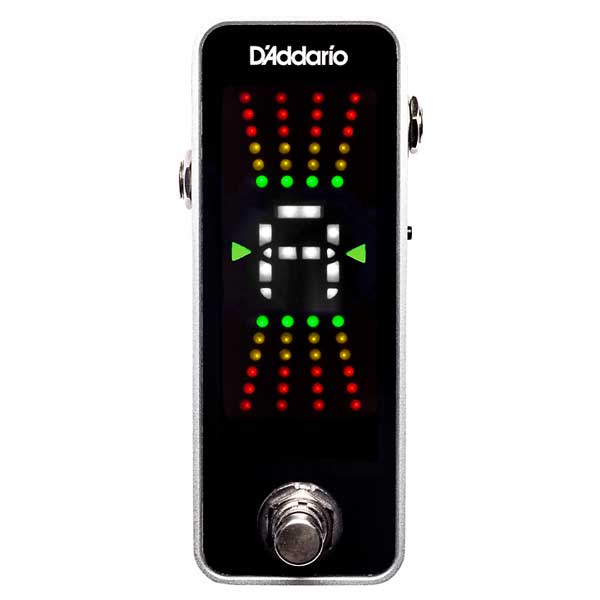
| Estimated Price | $90 |
| Tuner Type | Pedal |
| Display Type | Chromatic LED |
| Accuracy | 32-bit processing for precision |
| Alternate Tunings Available | Capo and DADGAD |
My Review: The CT-20 by D’Addario addresses the need for a slim, compact pedal that would appeal to most guitar players and deliver reliable performance on stage. D’Addario has over 4 decades of experience making guitar strings and accessories and therefore this device is greatly functional but keeps the focus on usability by avoiding any feature traps. The CT-20 is intuitive to use and can keep up with the higher end spectrum of the tuner market with not skimping on any essential features.
Build Quality: The CT-20 comes in a mini pedal format but its profile seems even smaller thanks to the rounded edges. The top is covered in a bright and colorful LED display with a clicky sounding footswitch on the bottom. The display has 2 sections, with one displaying the reference pitch and the upper section displaying pitch accuracy. It is easy to read and bright enough for outdoor situations. In order to reduce the size, the CT-20 does, however, miss out on a bypass output jack and a DC out jack.
Speed and Accuracy: The D’Addario CT-20 is a solid mid-range performer. It works with both guitar and bass, and although it’s not the fastest or the most accurate, it definitely performs with great consistency. The easy to read LED display makes it a breeze to use on-stage and the true bypass helps in keeping the signal path clean and error-free. The lack of a DC out jack may be a miss for some folks but keep in mind, the profile is so small that on small setups the CT-20 might just be worth the trade-off if you can add an extra pedal.
Alternate Modes and Tunings: The CT-20 is well suited to tune both guitars and basses from C0 all the way to highest notes at around E7. This makes it quite suitable for other stringed instruments as well. The CT-20 offers a no-nonsense operation with most standard tunings although there is no real option for alternate tunings.
Who Is It For: The D’addario CT-20 caters more towards the beginner and semi pro market although its internals is capable of so much more. The CT-20 is quite approachable for newer guitar players but can also function as a workhorse for Notable Features who want a tuning pedal for their compact rigs. The display is bright, accurate, and great for stage use and only the lack of a few additional features could hold it back. The lower price tag and slim build are great for anyone looking to make this pedal a part of their setup.
Notable Features:
- Slim, compact build with aluminum construction
- Stylish design with rounded edges
- Bright LED display
- Functions on 9V batteries or external power
- True Bypass
- 32-bit processing for accurate tuning
9. D’addario NS Micro
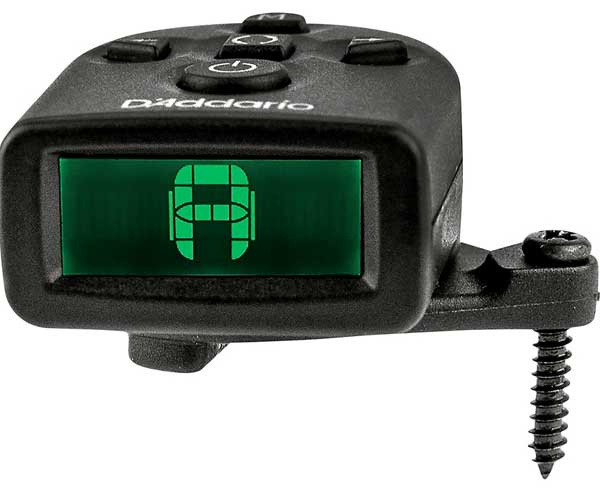
| Estimated Price | $15 |
| Tuner Type | Clip On Tuner |
| Display Type | Chromatic |
| Accuracy | Not Specified (Uses Vibration Sensor for Accuracy) |
| Alternate Tunings Available | No |
My Review: The NS Micro tuner is a budget-friendly, discreet and accurate product that works for a variety of stringed instruments. It bases its accuracy on the string’s vibrations, which means you need no cables for it to work. A large, backlit display screen easily shows the tuning details even under darkness, and can also double up as a visual metronome. Thanks to the reversible screen and adjustable design, it can be easily fitted to the front or the back of the headstock. If you’re looking for a compact, affordable, and simple tuning solution, the NS micro tuner is worth exploring.
Build Quality: The NS micro tuner has an impressively sleek and discrete design which, at a mere 1.25 inch in width, would be barely visible to the crowd if you’re using it onstage. The rubberized padded clamp makes sure that your instrument surfers no scratches or damage when it’s clipped on. Thanks to the 360-degree swivel design, the tuner caters to both right as well as left-handed guitarists. Moreover, the reversible screen means it doesn’t matter whether you mount it on the front or the back of your headstock. The tuner comes with a powerful CR2032 battery that allows hours of operation without hassle. The auto-off feature further preserves battery life.
Speed and Accuracy: The NS micro tuner boasts of a wide calibration range between 410 to 480 Hz, which means that you can not only tune your instruments in the typical 440 Hz pitch but also other standard pitches in case it’s required. The tuner allows for speedy tuning and is a significant improvement on the brand’s previous ‘mini’ tuner, allowing you to quickly tune the instrument.
Alternate Modes and Tunings: One of the coolest things about this tuner is that it doubles up as a visual metronome as well. This makes it more versatile and can help you practice your shredding chops in time, anywhere between 20 to 270 bpm.
Who Is It For: Given its incredibly affordable price point, long battery life, and dependable performance, the NS tuner works great for most guitarists on a budget. So much so that if you own multiple guitars or stringed instruments, you can buy more than one and clip one on each of the instruments and use it whenever you wish.
Notable Features:
- Sleek and discreet at only 1.25-inch width
- 360 swivel mechanism caters to both left and right-handed guitarists
- The reversible screen lets you clip it onto the back or front of the headstock
- Rubberized padded clamp eliminates the risk of scratches or damage to your instrument
- Large, backlit, colored visual display
- An adjustable calibration range between 410 to 480 Hz
- Long battery life, auto shut off within 10 minutes of no use
- Doubles up as a visual metronome
Related Popular Article: The Best Guitar Straps (And Most Comfortable)
10. Korg Sledgehammer Pro
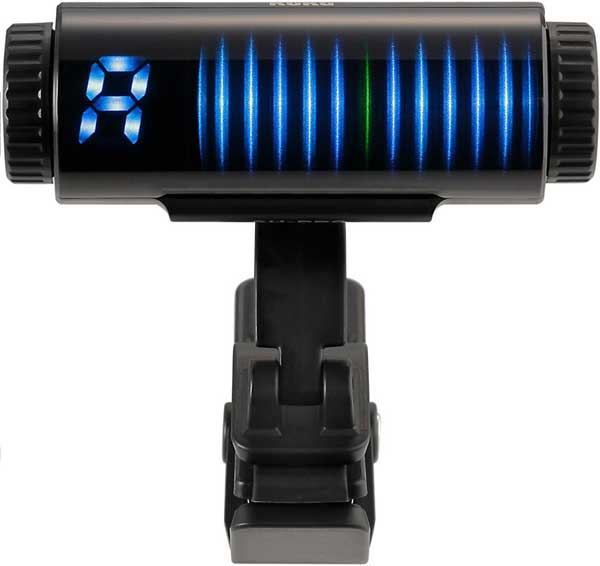
| Estimated Price | $20 |
| Tuner Type | Clip On Tuner |
| Display Type | Regular, Strobe, and Half Strobe |
| Accuracy | +/- 0.1 percent |
| Alternate Tunings Available | Calibration Mode For Alternate Tunings |
My Review: The Sledgehammer is the latest series of clip-on tuners by Korg, and the Sledgehammer is seriously worth a look for many reasons. For starters, its sleek tubular design has a shuttle switch that you can operate with one hand. The 3d visual meter has a vibrant LED display that’s easily visible no matter what the ambient lighting conditions are.
Secondly, the 14-hour battery life and the auto-off mechanism means your battery life stays preserved for long. Most importantly, it has impressive accuracy of +/- 0.1 percent and has three different meter display modes – regular, strobe, and half strobe. The adjustable calibration lets you tune to a variety of concert pitches. All in all, we suggest this as a tuner worth investing in.
Build Quality: The sleek, tubular design of the Sledgehammer Pro is easy to clip onto your guitar. The shuttle switch is fitted on both sides of the tuner, which makes it convenient to turn on and off with a slight turn. This design also lets you operate the device with just one hand, which is quite useful especially if you have to tune while you’re performing. The three-dimensional display is quite bright and allows for easy visibility even if it’s dark or under those mad stage lights.
It offers three different types of LED display modes – regular, strobe, and half strobe – and you can choose the one you prefer. In the regular mode, the area to the left of the center lights up when your string is flat, and to the right when it’s sharp. In the strobe and half strobe mode, the LED lights move rapidly if your string is out of tune, and slow down as the string comes closer to the desired tuning. Once the string is perfectly tuned, only the center light of the tuner will light up. The half strobe and the strobe options are ideal if you’re looking for an ultra-high precision display while tuning your instrument. The 14-hour operating life of its CR2032 battery keeps your tuner going for a long time, while the auto-off feature prevents unnecessary battery wastage.
Speed and Accuracy: With impressive tuning speed and accuracy of up to +/- 0.1 percent, the Sledgehammer Pro is incredibly accurate and especially so for a clip-on tuner. In fact, Korg claims its tuning precision to be comparable to that of the brand’s flagship rackmount tuner, the Pitchblack Pro.
Alternate Modes and Tunings: The Sledgehammer Pro offers a calibration feature that allows you to tune your instrument in different pitches. Moreover, its memory backup feature is quite handy and saves your preferred tuning settings for use in the future.
Who Is It For: Though it may be a tad pricier than its counterparts, the Sledgehammer Pro’s tuning accuracy, clear display, and easy to use design justify the price. It’s a clip-on tuner built for professionals and brings an impressive new level of tuning precision to clip-on tuners.
Notable Features:
- Easy to use, rotatable shuttle switch for use by one hand
- Sleek, tubular design
- 3D LED display for clear display under any kind of lighting
- Ultra-high precision accuracy of +/- 0.1 percent
- 3 display modes: regular, strobe and half-strobe
- Calibration feature and memory backup
- Ideal for professional guitarists and bassists
Related Article: Our Favorite Mini Guitar Amps
11. Peterson StroboClip HD
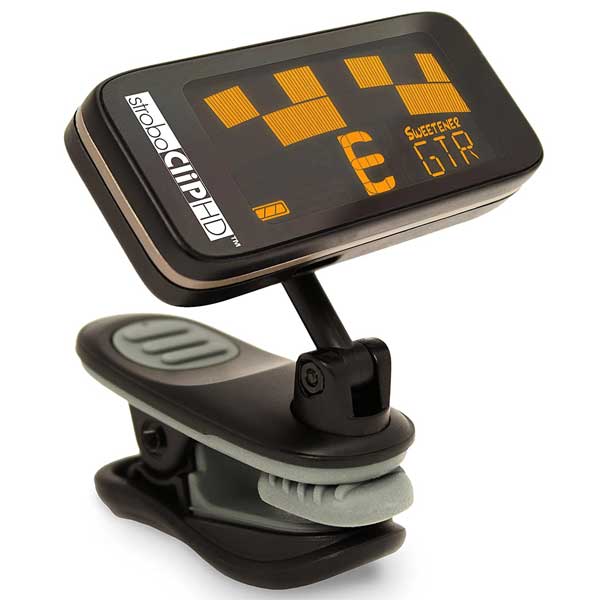
| Estimated Price | $70 |
| Tuner Type | Clip On Tuner |
| Display Type | Strobe |
| Accuracy | +/- 0.1 percent |
| Alternate Tunings Available | Capo and Drop Tuning |
My Review: The StroboClip is a high-accuracy, multi-purpose strobe tuner by Peterson that works not only for guitars but for a wide variety of stringed and wind instruments – even Bagpipes, how ‘bout that? With a wide and secure clasp design, 0.1 percent accuracy and an HD backlit display screen, it allows you to precisely tune your instrument in real-time under any lighting conditions. The auto transpose and capo tuning settings are quite handy features for those looking to do alternate/ drop tunings. But the feature that really caught our fancy was the 50+ pre-sweetened’ tunings that account for the inherent tuning discrepancies in different instruments. This allows you to accurately tune any instrument.
Build Quality: The Stroboclip has a wide and sturdy rubber-padded clamp that can accommodate headstocks of various widths as well as mountain locations for different instruments. Thanks to the rubber padding, not only does the grip stay secure, but the instrument’s finish stays protected from any scratches or damage. Its HD display screen is brightly lit and is easily visible under poor lighting conditions as well.
Speed and Accuracy: This strobe tuner offers an impressive real-time accuracy of 0.1 percent. This is possible thanks to over 192 tuning segments that show even the slightest of pitch changes so that you’re able to perfectly tune it. True to tradition, the light bands on the tuner will move to the left if your tuning is flat, and to the right, if it’s sharp. The furiously scrolling strobe light bands will start slowing down as you come closer to the right tuning, and momentarily stop after you strike the note when it’s perfectly tuned.
Alternate Modes and Tunings: Like we said at the beginning of the view, the feature that really ‘sweetens’ this deal for us is the 50+ preset sweetened tunings that account for the inherent tuning issues that each instrument exhibits so that they can be corrected. This level of customization is well appreciated, especially by professionals. Aside from this, the auto transpose feature and the capo tunings further expand the tuner’s functionality.
Who Is It For: Sure, the StroboClip is pricier than your other friendly neighborhood tuners, but for good reason. This is an all-in-one tuner that can help you tune any instrument in your arsenal, be it a ukulele, a violin, bass, bagpipes, and more. Given its sturdy, well-cushioned build, accuracy, and versatility, this one is a good investment for professionals.
Notable Features:
- High accuracy strobe tuner
- Can be used to tune a host of stringed and wind instruments
- Wide, rubber-padded clamp fits well on any instrument
- HD, backlit display shows slightest pitch deviation
- Over 50+ preset ‘sweetened tuning’ to correct inherent tuning issues in a variety of instruments
- Auto-transpose and capo tuning feature
12. Roadie 2 Motorised Tuner
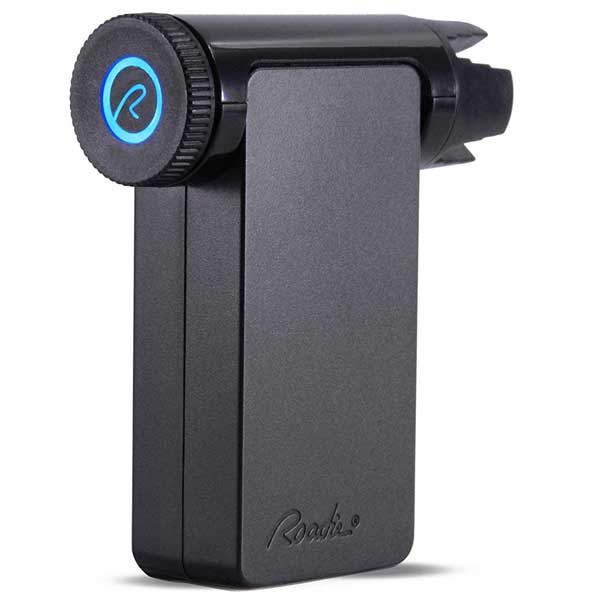
| Estimated Price | $130 |
| Tuner Type | Motorized Tuner |
| Display Type | OLED display |
| Accuracy | Detection accuracy of +/- 1 percent, Tuning accuracy of +/- 2 percent |
| Alternate Tunings Available | Yes, includes an app to create customized tunings |
My Review: Not all guitar tuners rely on microphones or input signals to tune. The Roadie 2 automatic guitar tuner takes a fundamentally different approach to guitar tuning. It is essentially a mechanical tuner that can use built-in mechanicals and sensors to tune strings to near perfection. The actuator in the device is able to perform micro-movements and hence Roadie affords high precision tuning for guitar players at all levels.
Build Quality: The Roadie 2 device is quite lightweight at 3.2 ounces and primarily made out of plastic. The top of the device houses the OLED screen, a knob interface on one side, and the tuning peg connector on the other. The connector is designed to work with tuning pegs of most major instruments. The knob interface houses a small backlit ‘R’ LED indicator for selecting options. The small screen mainly acts as a guide for selecting various tunings and the correct string to tune.
Speed and Accuracy: The Roadie 2 claims to have a 30 second tuning time but that might only apply to more experienced users. The interface is one button and super intuitive to use but In my experience, it takes a while for the device to make coarse adjustments. However, a quick tune-up between songs takes no time at all. The Roadie very handily vibrates a little when the string is tuned. Great haptic feedback to ensure quicker operation. The tuning is accurate to +- 2 percent which is more than accurate for most live situations.
Alternate Modes and Tunings: The Roadie 2 supports a wide variety of custom tunings, from Drop D, Drop C, DADGAD all the way to custom tunings for other stringed instruments with tuning pegs. The Roadie 2 can store up to 40 tuning presets at a time and can also be loaded with more presets via the Roadie app.
Who Is It For: Roadie has enjoyed a stellar reputation among the guitar player community. This device offers to solve a lot of common problems for guitar players. For example, it can also wind the strings making it so much easier than conventional mechanical string winders. While it’s priced on the higher side of most tuning pedals, the functionality is really good and most guitar players will find a lot of value in the purchase, but don’t forget to keep it charged!
Notable Features:
- All in one guitar tool – winder, tuner and quick solution to managing alternate tunings
- Even winding ensures less damage to the strings and longer life
- Advertised month-long battery life
- Uses vibration sensor (not microphone) for accurate pitch detection
- Reasonably priced
13. GuitarTuna Guitar Tuning App

| Estimated Price | Basic Version is Free, Pro Version costs $12.99 with add on features available |
| Tuner Type | Phone App |
| Display Type | Chromatic |
| Accuracy | Not Specified (Uses your phone’s internal mic to detect sound) |
| Alternate Tunings Available | Multiple: Drop A, Drop D, etc. |
My Review: With over 80 million downloads on Android and iOS, GuitarTuna is one of the most downloaded tuner apps on either platform. A product of Yousician, this app uses your phone’s microphone to detect sound with their proprietary audio recognition technology and ambient noise-canceling feature. Aside from being a multi-instrument tuner, it comes with a plethora of other useful features.
It also comes with a huge set of preset tuning – Drop D, drop A, and half step-down, among others. Moreover, it doubles as a metronome with a tap for tempo function, ear training tool, chord guide, and more. Whether you have a guitar, a bass, violin, or cello, its chromatic tuner function allows you to tune any instrument. You can get the basic version of this app free, or subscribe to the paid version for chromatic tuning, custom tuning, and other features.
Build Quality: Since this is a tuning app, let’s talk about the software’s overall functionality. The user interface is quite easy to access and navigate. The moment you open the app you see the headstock of a guitar with all 6 knobs representing various strings. Simply bring the phone close to your guitar and strike each string one by one. The app’s proprietary audio recognition feature picks up the pitch instantly.
Speed and Accuracy: The software works impressively well for tuning, but its actual performance may differ from phone to phone. The app’s noise-canceling feature does a good job of cutting out ambient noise while it works. However, it will work best in a relatively quieter environment, since no matter how good its recognition software is, it still is dependent on your phone’s mic to pick up the original sound.
Alternate Modes and Tunings: The app comes with a huge number of alternate tunings. Aside from the standard EADGBE, you have the Drop D, Drop A, Half Step Down, and other alternate tunings. It has ready-made tunings for a 4 string bass, a ukulele, and even exotic folk stringed instruments like a Cavaquinho. Another impressive thing about the app is that it gives you handy tips on how to strum your instrument (for eg. in the case of the Cavaquinho) when tuning it.
Who Is It For: Given the fact that its tuning functionality is available free of cost, this is a useful and handy app to have on your phone at no cost. However, do keep in mind that its chromatic tuner is only available to those who subscribe to its paid Pro version. Even if you have a physical tuner, keeping GuitarTuna downloaded on your phone as a backup is a good idea. If you’re keen on unlocking the app’s extra features like chord guide and guitar exercises, then you will have to subscribe to its Pro version. This is one of the best guitar tuner apps out there, period.
Notable Features:
- Free tuning app
- Offers a wide variety of alternate tunings
- Can be used to tune various stringed instruments
- Easy to use interface
- Also has a tap-to-tempo metronome feature
- Extra features like chord guide, ear training tool and more in the paid Pro version
14. Fender Tune Guitar Tuning App

| Estimated Price | Basic Version is Free, Pro Version costs $9.99 per month or $89.99 for an annual plan |
| Tuner Type | Phone App |
| Display Type | Chromatic |
| Accuracy | Not Specified (Uses your phone’s internal mic to detect sound) |
| Alternate Tunings Available | 26 Preset Tunings Available |
My Review: In Late 2016, legendary guitar makers Fender decided to venture into the guitar tuning space with the Fender Tune. A free to download app that’s upgradable to a paid version, it offers an easy to navigate user interface and lets you accurately tune your acoustic and electric guitar, bass, and ukulele in a variety of standard and alternate tunings. It has chromatic, manual, autotune, and custom tuning modes.
While in the auto mode, the app tunes in and picks up your string’s sound to guide you to the correct pitch, in the manual mode, it plays out the correct pitch so you can manually tune the stringing up yourself. Aside from standard tuning, it also has 26 pre-set alternate tuning options, ranging from DADGAD, Open G, Drop C, and more, for all you alternate tuning players. While this is all available free of cost, you can pay a nominal one-time sum to unlock the app’s useful guitar practice toolkit that includes a Pro tuner that offers an even more precise tuning, a metronome, a chord guide, and over 2000 guitar scales for practice.
Build Quality: The Fender Tune has a clean, user-friendly interface that readily shows a couple of tuning options – auto, manual, and Pro tuner (requires in-app purchase). The auto mode listens to your string’s pitch thanks to your phone’s mic and guides you to the correct pitch. In the manual mode, the Fender’s signature headstock appears and you can select whichever string’s pitch you’d like to hear in order to manually tune-up.
Speed and Accuracy: The app picks up the sound signal via your phone’s mic, so the closer you place your guitar to the phone and the quieter the surroundings are, the better the result will be. In our experience, it is fairly accurate and quick for a guitar tuning software. The paid version of the app unlocks the Pro tuner that allows for tuning with more visual precision and flexibility. The Pro tuner opens up wider tuning styles with explicit percent and hertz details. You can choose from a different wider tuning calibration, with 40 tuning references falling between 420 to 460 Hz.
Who Is It For: As a free app, Fender Tune works well for beginners and enthusiasts alike. With this free version, you get to tune acoustic, electric, bass guitars, and ukulele. With the paid version, you get access to the Pro tuner that claims to be even more high precision, which may work for professionals as a good back up to have on their phones.
Alternate Modes and Tunings: The free app mode offers personalized tuning for electric guitar, acoustic, bass, and the ukelele at a pitch of 440 Hz. Moreover, it also has over 20 pre-set alternate tunings – from Drop D, Half step up, Open C, and many more. It also has a chromatic tuner mode for those looking to custom tune their guitar to an alternate tuning. Another thing worth mentioning is the instrument-wise tuning tips that they offer on the app, which will be particularly useful for beginners.
Notable Features:
- Offers easy to use tuning app free of cost
- Personalized tunings for electric, acoustic, bass, and ukulele
- Choose from over 20 alternate tunings
- Offers both manual and auto-tuning mode
- Pro version offers a high precision tuner with a wider calibration range
- The paid version also offers a guitar practice toolkit that includes a metronome, chord guide, and a scale guide
Choosing a Guitar Tuner (Buying Guide)
Types of Guitar Tuners
Modern electronic tuners have evolved from traditional devices like tuning forks. The concept, in essence, is the same, the pitch of the instrument is matched to a reference pitch, either manually or automatically detected by circuits in the tuner.
Strobe Tuners
Strobe tuners, short for Stroboscopic Tuners, are either mechanical tuners with rotating mechanical disks, or electronic tuners with an LED display that mimics the rotating disk; or are available in software, app, or plugin form as well. The tuner has a rotating disk that shows the reference pitch and a light behind it flashing at the frequency of the note that is being played. Strobe tuners can detect the signal either through microphones or through an input jack, making these tuners extremely versatile.
When the note is tuned, the disk rotating at the fixed reference frequency and the light flashing at the input signal frequency will match, due to the ‘persistence of vision’ and will appear steady.
The disks will show even a minute difference of pitch between the reference and the source sounds so the pitch accuracy is extremely high. In commercial strobe tuners made by Peterson for example, the pitch accuracy comes down to a 10th of a percent meaning extremely accurate tunings can be achieved.
Such high accuracy also gives a slight advantage to strobe tuners as tunings can be used to compensate for certain characteristics or quirks that might occur with every instrument. A Les Paul, for instance, has a 3rd string that sounds better when tuned down ever so slightly, a result that cannot be achieved with other types of tuners.
Strobe Tuners offer many advantages but are often slow for a quick onstage tune-up. Many professional guitar players, who often used alternate instruments like 12-string guitars appreciate the granular pitch accuracy of strobe tuners. In the studio, they are an essential tool for orchestral recordings. Mechanical strobe tuners have gone out of style however, electronic and software tuners have become really popular today.
Chromatic Tuners
Chromatic tuners take advantage of various electronic components to read the frequency of an input signal. These tuners have gained popularity in recent years thanks to innovation in microprocessors and software. The input signal shows up as a reading on the VU meter needle with +/- indicators showing the difference in relative pitch.
Tuner pedals like the BOSS TU-3 have an LED display that shows the reference pitch and the VU meter above it will show the deviation. A perfectly tuned note will be signaled by the needle at 90°. This type of tuner is inherently much faster and slightly more intuitive to use than strobe tuners but sacrifices a bit of accuracy overall. Most modern chromatic tuners come with a strobe mode as well but it’s more of a display mode than an actual strobe tuner as their functioning is completely different.
Chromatic tuners are greatly accurate with most tuners in the region of +/- 1 or 2 percent. Because of the various instruments that need tuning, modern tuners come with built-in circuitry that can automatically estimate the reference pitch while tuning. So for standard guitars tuned to EADGBE, the tuner can detect whether an A string is being played and display the deviation from A=440hz automatically.
Polyphonic Tuners
Polyphonic tuners are a recent innovation in the tuning world. Aimed specifically at guitar or bass players, polyphonic tuners try to solve the problem of tuning on-stage quickly by strumming the instrument just once to display pitch deviation on all its strings. This type of tuning method was pioneered by TC Electronic with their Polytune 1 pedal.
The technology behind this pedal was borrowed from their vocal processing units that can detect, correct, and harmonize polyphonic sound sources such as vocals. The polytune 3 can freely switch from polyphonic mode to monophonic chromatic mode if only one string is picked. Polyphonic tuning is the fastest method but delivers the least amount of pitch accuracy overall. It is really great for quick tune-ups on stage or in the rehearsal room, especially only if a few of the strings are out of tune.
Players can quickly identify which one and correct their pitching on the fly. Polyphonic tuning can also help to quickly restore accurate tuning between takes in the studio. In terms of accuracy, however, polyphonic tuning can be accurate up to =/- 1 to 2 percent. Whereas the Polytune 3 is a great chromatic tuner and highly accurate at up to +/- 0.5 percent.
Different Types of Guitar Tuner Builds and Designs
Depending on the type of instrument, there are various kinds of tuners out there to suit every need. But broadly, they can be divided into the following types –
Clip-On Guitar Tuners
Mainly suitable for acoustic instruments, like the guitar or trombone. The Clip-On tuner was invented in 1995 by Mark Wilson and was called the Intellitouch Tuner P1. A clip-on tuner works by latching on to the headstock of a guitar or the bell of a trombone and picks up vibrations that are detected by the on-board circuitry and displayed. Almost all clip-on tuners do not depend on microphones and hence are great for tuning in gig situations or in other loud environments, even when other musicians are tuning.
Some clip-on tuners like the Snark ST-2 will include an additional microphone to increase its sensitivity or make it more accessible to tune different instruments. These tuners are often made from plastic components to save weight hence it’s a good idea to take care while using them.
Rack Mounted Guitar Tuners
Rack-mounted tuners are targeted at professional musicians who carry touring rigs over long distances either by road or in flights. These tuners work great with these rigs as a rack with a toughened outer case provides a stable workflow for tours that can sometimes last for months or years even.
Rack-mounted tuners are also relatively high-end pieces of technology with extremely high accuracy and a lot of options for fine-tuning. For example, the Stroborack unit from Peterson tuners is a rack-mounted unit that is also a highly accurate strobe tuner and works great in the studio as well! Rack units can also have multiple inputs for more complex rigs and more advanced features such as storage and recall of customizable profiles for tuning specific guitars.
Pedal Tuners
The most common form of tuners, pedals are usually made from die-cast metals or aluminum. They either come in a stomp-box pedal form or a smaller mini-pedal style. While most tuner pedals are chromatic, you can also find digital strobe tuner pedals like the Strobostomp HD or the Vox VXT-1 strobe tuner pedal. A tuner pedal also performs more functions than just tuning instruments.
For electric guitars and pedalboards, tuner pedals can perform a buffered bypass that enhances the amplitude of the signal to compensate for the loss of gain while using multiple stomp pedals. They often come with a DC power out jack that can be used to power other pedals like drives or delays and save space or available power on the power supply. Some popular pedals like the BOSS TU-3 have been covered in this review.
Guitar Tuning Apps/ Software/ Plugins
The advent of smartphones has resulted in the emergence of a lot of tuning apps or software. While most DAWs or Digital Audio Workstations have some sort of tuner built-in to their plugin suite, there are quite a few options around. The HotTuna Tuner by Blue Cat Audio is a software plugin that performs chromatic tuning at a fraction of the price of any physical tuner.
A lot of apps on iOS and Android offer varying degrees of functionality at different price-points and we have covered some apps in our review as well. The quality and accuracy of the process, however, are sometimes dependent on the quality of the mic in the smart device, and consequently, your results may vary.
While there are popular tuning apps like GuitarTuna or Fender Play, feel free to experiment with others as they all have their unique quirks.
Conclusion:
Well, there you have it, a comprehensive guide, and a list of some of the best tuners available out there today!
I hope this guide helps musicians across skill levels and experience. When it comes to tuners, speed and accuracy are the name of the game but clearly not every tuner is meant for everybody. For beginners, even a free app may do the job, but for those looking for a more permanent solution, there are lots of pedals, clip-ons, and even some dedicated rack units to choose from.
For professional situations, such as a commercial recording studio or a rig designed for touring, visibility of the display and efficiency become far more important. Strobe tuners work great for such situations where a guitar technician might handle the tuning and ensure crisp and precise intonation for the artist. In the studio, they work really well, as they can handle various types of instruments.
New innovations such as the Polytune 3 polyphonic tuner pedal and the Roadie motorized guitar tuner are really pushing the limits of what the humble tuner pedal can do. Additional features such as buffered bypass will help guitar players maintain and even enhance their tone and eliminate unwanted noise. Since tuner pedals can even power other pedals they are often problem solvers when it comes to generating that perfect tone with greater consistency.
Hope this guide helps you make your next tuner purchase with confidence! Do you agree with our list? Let us know what you think of these pedals in the comments below!

My name is Chris and I’ve had a passion for music and guitars for as long as I can remember. I started this website with some of my friends who are musicians, music teachers, gear heads, and music enthusiasts so we could provide high-quality guitar and music-related content.
I’ve been playing guitar since I was 13 years old and am an avid collector. Amps, pedals, guitars, bass, drums, microphones, studio, and recording gear, I love it all.
I was born and raised in Western Pennsylvania. My background is in Electrical Engineering, earning a Bachelor’s degree from Youngstown State University. With my engineering experience, I’ve developed as a designer of guitar amplifiers and effects. A true passion of mine, I’ve designed, built, and repaired a wide range of guitar amps and electronics. Here at the Guitar Lobby, our aim is to share our passion for Music and gear with the rest of the music community.

It’s hard too find experienced people about this subject, however, you soun lke yyou know
what you’re talkin about! Thanks